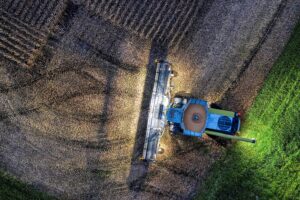 Happy National Farmers Day!
Happy National Farmers Day!
We want to start by saying “thank you” to the agricultural sector’s producers of crops and livestock, as well as the many farm services firms that support them. The agricultural sector comprises about 1.47 million crop producers, 566,600 livestock producers, and 14,600 farm support services firms, and each are a working part of our economic backbone.
As a company that provides Industry Intelligence focused on specific niches, industries, and sectors of the U.S. and Canadian economies, we know how important the agricultural sector is. According to the United States Department of Agriculture (USDA), agriculture accounts for around 0.6 percent of the U.S. GDP, and it actually expands beyond that because its relative sectors rely on agricultural inputs.
Examining the size and structure of the agriculture subsectors
Crop producers
-
- Crop farms produce about $184 billion of annual value, using more than 421 million acres.
- About 98 percent of farms are owned by farm families where the family owns and/or operates the farm and has done so for generations.
- Small family farms (less than $250,000 in annual sales) make up 88 percent of U.S. farms and hold 51 percent of all farm assets. Large farms (more than $1 million in annual sales) account for 68 percent of the production value.
Animal producers
-
- Livestock farms produce about $177 billion in average annual value on over 478 million acres.
- About 90 percent of livestock farms are owned by farm families in which the family owns and/or operates the farm and has done so for generations.
- Farm operations that generate more than $1 million in revenue account for 79 percent of livestock production value.
Farm support services
-
- Farm support services include more than 9,500 companies and generate over $24 billion in annual revenue.
- 92 percent of companies are small, employing 20 or fewer people.
- 22 percent of firms are female-owned, 15 percent are minority-owned, and 10.6 percent are veteran-owned.
Growth forecast
Overall, U.S. GDP is expected to grow at a compounded annual rate of 5.5 percent in 2021-2026. By comparison, sales in the agriculture sector are expected to grow at a rate of 5.14 percent for crop producers, 5.53 percent for animal producers, and 2.88 percent for farm support services.
According to Inforum and the Interindustry Economic Research Fund (IERF): “The agriculture, forestry, fishing, and hunting industries should see healthy revenue growth in coming years. While inflation likely will diminish, price levels may remain high for food and other products.”
Annual growth across the agriculture subsectors
| Ag Subsector | 2022 | 2023 | 2024 | 2025 | 2026 |
| Crop Production | 11.83% | 5.04% | 3.35% | 2.86% | 2.89% |
| Animal Production | 12.68% | 5.67% | 3.66% | 2.96% | 2.99% |
| Farm Support Services | 6.09% | 3.25% | 2.09% | 1.54% | 1.52% |
Source: Inforum and IERF
It’s not all rosy
The agricultural sector is facing a unique combination of headwinds and tailwinds. Revenue growth is forecasted, yet the sector also continues to struggle with inflationary pressures, ongoing supply chain disruptions, and other short- and long-term challenges such as:
-
- The prices of inputs such as feeds, seeds, animals, chemicals, and fuels have risen and are pressuring agricultural producers’ profit margins. Input costs have been rising faster than the prices that farmers and ranchers receive for their products. Inflated prices also are driving some animal producers to sell off livestock.
- Drought in the West is hampering crop production and reducing yields. Wildfires, hurricanes, and other natural disasters have damaged crops and rangelands in affected areas. Outbreaks of avian flu are forcing the destruction of infected flocks to minimize the spread. Impacted farms can apply for financial support through the USDA.
- Agricultural producers are experiencing growing pressure to decrease sector-wide carbon emissions and pollution. Environmental metrics have begun to factor into purchasing decisions, along with cost and growth performance.
The big picture
It is important for bankers and advisors to understand the reach of the agricultural sector in specific industries and niches so they can evaluate risk and help their existing clients.
Using our Industry Intelligence to dive deeper into business valuation data, financial benchmarks, and industry forecasts can add value to your client conversations and help them choose the best course of action for their agricultural businesses. Data – such as the farm services firms referenced – is both useful and valuable in helping firms achieve trusted advisor status with their agricultural clients.
>> Are you looking for deeper industry insights and outlooks on the agricultural sector? View our Industry Profiles to learn more!
Image credit: Tom Fisk via Pexels